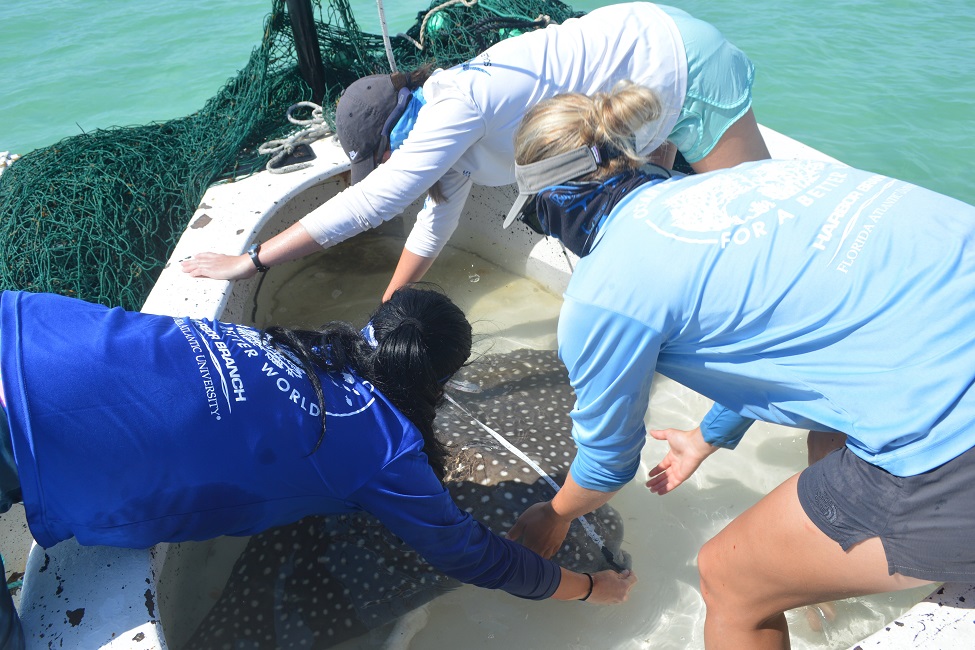Crushed Clams, Roaming Rays: Acoustic Tags Show Predator Interactions

Researchers shown with a whitespotted eagle ray (Aetobatus narinari), a highly mobile animal with a mighty jaw and plate-like teeth. (Photo credit: Kim Bassos-Hull)
Clam leases are designated underwater locations used to produce hard clams of all sizes from littlenecks to chowders. Clam production or aquaculture can be a risky business due in part to unwanted marine intruders. Among them, stealthy and highly mobile rays.
The Indian River Lagoon is one key location used for hard clam (Mercenaria mercenaria) aquaculture operations along Florida’s Atlantic coast. Clam fishermen have anecdotally reported seeing rays in clam leases and suspect that their interactions could result in damaged aquaculture gear and crushed clams. After all, some species of rays are equipped with mighty jaws and plate-like teeth that make them highly capable culprits.
Inspired by clammer reports, researchers from Florida Atlantic University’s Harbor Branch Oceanographic Institute and collaborators, used passive acoustic telemetry to gauge the interactions between two highly mobile animals, whitespotted eagle rays (Aetobatus narinari) and cownose rays (Rhinoptera spp.) in two clam lease sites and four other sites in Sebastian, including the Sebastian Inlet and the Saint Sebastian River mouth. Since visual observations can be challenging and unpredictable, this technology enabled researchers to monitor the tagged rays in the wild over two years.
“We wanted to understand how often and when rays visited these clam leases, how long they stayed there, and if it was seasonal or year-round,” said Matt Ajemian, Ph.D., senior author, an associate research professor and director of the Fisheries Ecology and Conservation Lab at FAU Harbor Branch. “We tagged them, set them on their way and logged 17,014 unique visits to the leases derived from 38 different rays.”
Findings from the study, published in PLOS ONE , provide both good news and bad news for clammers. Rays spent even more time in these clam lease sites than clammers reported or suspected, but it’s not necessarily where they prefer hanging out. For example, whitespotted eagle rays spent only 6.2 percent of their time near clam lease locations and cownose rays 13.2 percent.
Predicting when and for how long rays visit the clam leases also was complicated as it depended on the species, time of day, season, and even certain environmental conditions. Despite less frequent use when compared to other reference receiver locations, both species of rays exhibited longer visits at clam lease sites than some locations considered and were periodically observed within the clam lease regions for extended periods of time. The longest continuous duration spent at the northern and southern clam leases were 387.5 and 207.1 minutes, respectively. This shows that rays can remain within these areas for hours at a time, which increases the likelihood in which they are interacting with, and potentially foraging upon, the clam leases.
“Since 84 percent of all visits were from whitespotted eagle rays and their visits were significantly longer at night, this information suggests that observed interactions with the clam leases are potentially underestimated, given most clamming operations occur during daytime,” said Brianna Cahill, corresponding author, an FAU Harbor Branch marine science and oceanography graduate, and a research technician at Stony Brook University. “Results from our study justify the need to continue monitoring mobile predators in the region, including more studies to assess their behaviors such as foraging at the clam lease sites.”
Cownose rays and whitespotted eagle rays have different migratory patterns, but in both cases their tendency to be mobile may limit their impacts on clammers.
“Additional good news for clammers is that rays did not use the clam lease sites year-round, and their visits varied seasonally, with substantially fewer detections and visits during the summer months,” said Ajemian. “This suggests that clammers need only deploy anti-predator protections against rays, if needed, for a portion of the year.”
Findings from the study also highlight the need to understand if clam leases are situated within rays’ natural foraging habitats and if rays are actively interacting with the clam leases or if they may be attracted to other organisms nearby.
“It’s possible that rays may be feeding on other organisms that are attracted to the clams in the clam lease sites, as bivalve aquaculture farms have been known to change community structure and attract a wide variety of predatory snails, that may be an alternative attractant for cownose and whitespotted eagle rays given their diets,” said Cahill.
Study co-authors represent the University of Massachusetts Dartmouth; Bonefish and Tarpon Trust; Smithsonian Environmental Research Center; and Dalhousie University in Canada.
-FAU-
Latest Research
- FAU Researcher Lands Grant for Personalized Cancer Radiation TherapyThe project, led by Wazir Muhammad, Ph.D., will employ AI, specifically deep reinforcement learning, to analyze multimodal data, improving cancer characterization and treatment for better patient outcomes.
- FAU/Mainstreet Poll: Harris Narrows Trump's Lead to 5 PointsNew FAU poll highlights current voter leanings that were examined immediately before U.S. President Joe Biden announced he was leaving the race.
- National Poll Shows Small Trump Bump Post-Assassination AttemptA new poll of the battleground states of Georgia and Virginia highlights current voter leanings that were examined immediately before and after the attempted assassination of former U.S. President Donald Trump.
- FAU Expert: These Banks Are at Higher Risk of a Depositor RunMore banks are at an increased risk of having a liquidity crisis caused from withdrawals by large uninsured depositors, according to an analysis from a finance expert at Florida Atlantic University
- Digital Self-Harm Surges Among U.S. Teens from 2016 to 2021A new study finds that digital self-harm, where individuals anonymously post or share hurtful content about themselves online, has increased more than 88% since 2016 among 13 to 17 year olds in the U.S.
- National Poll: 45% of Democrat Voters Say Biden Should Not RunA new poll conducted by Florida Atlantic University's PolCom Lab and Mainstreet Research USA examines the state of the presidential election as reverberations of last week's debate continue to play out.






